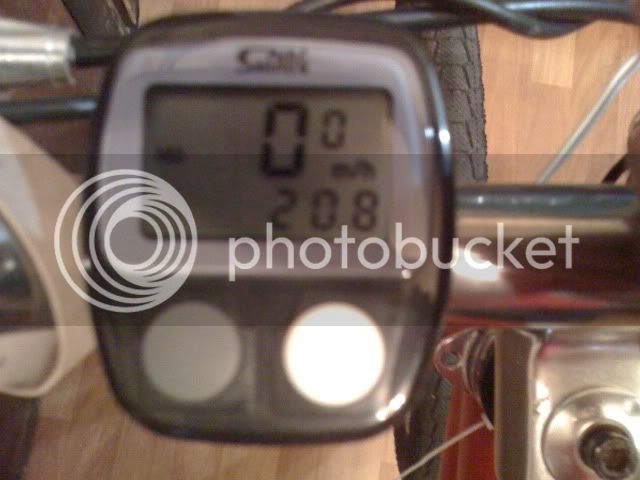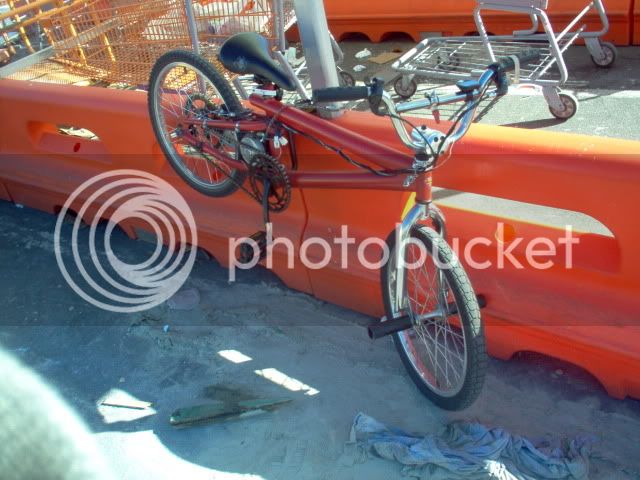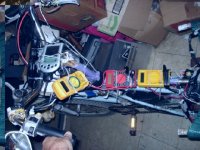Missed this thread before, but a few things:
To find out the right gearing for what that motor was "designed" for, look at the scooter it came from. I had a trashed ScootNGo I took apart, which had a 24V 250W Unite motor (already damaged, unfortunately), geared about 5:1 with an 11t motor end sprocket and a wheel end sprocket of 54 or so, I think it was, about a handspan across. The wheel was 8" diameter.
So in order to use the motor the way it was designed, I'd have to either use the same diameter wheel, or change the gear ratio to match a larger wheel. I always get confused with gear ratios as to whether I go up or down for things, so this could be wrong, but I think I would have needed to use a much larger wheel end sprocket to make up for the much larger wheel, to keep the motor using the same power and at the same wheel speed. (might be needing a *smaller* wheel sprocket instead).
After you have figured out what size sprocket to use at the rear wheel to make it spin the *same* speed as the original wheel, then if you want the motor to turn the wheel faster than it would have turned the original wheel, you'd use a smaller wheel sprocket than that, or a larger motor sprocket, or both. This results in less torque, but more motor loading and possibly overheating at lower speeds but high throttle (like startup from a complete stop). Pretty sure this is what finally smoked the little one I had.

If you want the motor to turn the wheel slower than the original wheel, use a larger wheel sprocket or smaller motor sprocket, or both. This results in more torque, but also less motor loading at lower speeds.
Regarding the SLA, are those the little 12Ah? or are they smaller, the 7Ah? Basically if you are drawing 10A then yeah, they won't last long on each ride. Getting down to 50% DOD (a good safe cutoff) is only going to take about 15 minutes or less. Even if you go to 80% DOD (shortening their life significantly, most likely) you'll only get another few minutes at best, in my experiences with them on DayGlo Avenger's radiator fan motor setup.
In your efficiency measurements, your motor is rated as capable of dissipating 250W of power. That doesnt' mean that 10.4A is the limit of the current it would draw; or even the average. So that current could be significantly different from the actual one. Do you have access to at least one of those cheap Harbor Freight meters? They can take 10A for "30 seconds" without melting the shunt off the board (which can be put back on, don't worry...ask me how I know

), and higher currents for shorter times. You could zip tie it to the top tube, go to an empty parking lot, and hit full throttle while watching the meter to see what current starts at and what it is at at different apparent speeds and throttle percentages.
BTW, I think you mean Wh/Mile, rather than Wh/hour.

Now, 83Wh/mile is pretty danged high, but not necessarily unexpected if the motor sucks lots of current all the time, especially if you're just letting the motor do the work and not pedalling hard enough to help it. It's worse if you also don't pedal for startups from complete stops, because it uses up a LOT of power to get that work done--more than most other times, though for a shorter amount of time. Partly it does depend on your gearing. If you optimize the gearing for speed, you're going to have a higher cost of power getting to that speed. If you optimize the gearing for torque then you may save significant power at the startup and slower parts of getting up to speed (assuming full throttle for all conditions).








